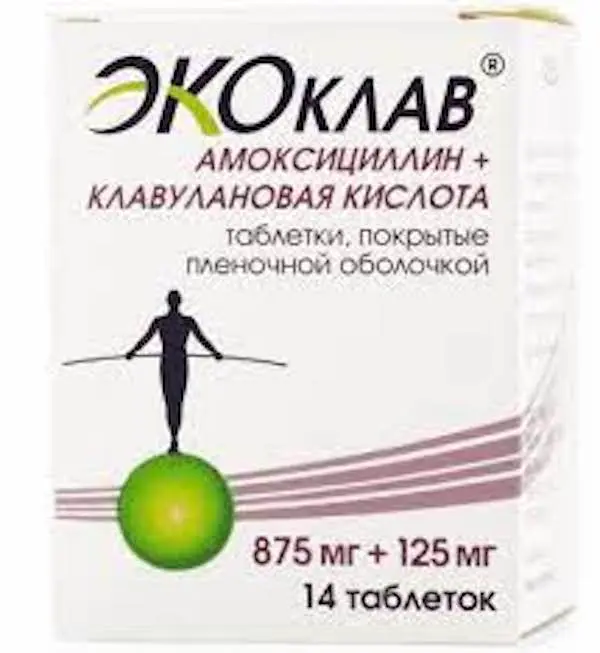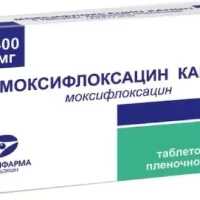Description
Ecoclav tablets Pharmacodynamics
Combination preparation of amoxicillin and clavulanic acid – beta-lactamase inhibitor. Amoxicillin is a semi-synthetic broad-spectrum antibiotic; it acts bactericidally by inhibiting the synthesis of the cell wall protein of sensitive bacteria in the growth stage. Clavulanic acid has high affinity to bacterial beta-lactamases and forms a stable complex with them. Thus, biodegradation of amoxicillin by beta-lactamases is prevented and bactericidal activity of the antibiotic is preserved. Clavulanic acid inhibits beta-lactamases of types II-V according to the Richmond-Sykes classification and is not active against beta-lactamases of type I produced by Pseudomonas aeruginosa, Serratia spp. and Acinetobacter spp.
Combination preparation of amoxicillin and clavulanic acid is active against the following microorganisms according to the results of in vitro tests and clinical studies:
Gram-positive aerobic microorganisms:
Staphylococcus aureus (beta-lactamase producing and non-producing strains);
Gram-negative aerobic microorganisms:
Enterobacter spp. (despite the fact that most strains of Enterobacter are resistant in vitro, the drug has been clinically proven effective in the treatment of urinary tract infections caused by this pathogen);
Escherichia coli (beta-lactamase producing and non-producing strains);
Haemophilus influenzae (beta-lactamase producing and nonproducing strains);
Klebsiella spp. (all known beta-lactamase producing strains);
Moraxella catarrhalis (both beta-lactamase producing and nonproducing strains).
According to the results of in vitro studies, the sensitivity to the combination of amoxicillin and clavulanic acid has been shown for the following microorganisms:
Gram-positive aerobic microorganisms:
Enterococcus faecalis**;
Staphylococcus epidermidis (beta-lactamase-producing and non-producing strains);
Staphylococcus saprophyticus (beta-lactamase producing and nonproducing strains);
Streptococcus pneumoniae** (does not produce beta-lactamases);
Streptococcus pyogenes** (does not produce beta-lactamases);
Streptococcus spp. viridans group** (does not produce beta-lactamases).
Gram-negative aerobic microorganisms:
Eikenella corrodens (beta-lactamase producing and non-producing strains);
Neisseria gonorrhoeae** (beta-lactamase producing and non-producing strains);
Proteus mirabilis** (beta-lactamase producing and nonproducing strains).
Anaerobic microorganisms:
Bacteroidesspp. including Bacteroides fragilis (beta-lactamase producing and nonproducing strains);
Fusobacterium spp. (beta-lactamase producing and nonproducing strains);
Peptostreptococcus spp. (does not produce beta-lactamases).
NOTE: ** – (amoxicillin has been clinically proven effective in the treatment of several infections caused by these pathogens).
Lactulose, which is included in Ecoclave as a bifidogenic factor, is a synthetic disaccharide whose molecule consists of galactose and fructose residues. Lactulose is not absorbed or hydrolyzed in the stomach and upper intestines. Released from Ekoklava tablets lactulose as a substrate is fermented by normal microflora of the large intestine, stimulating the growth of bifidobacteria and lactobacilli. As a result of hydrolysis of lactulose in the large intestine are formed organic acids – lactic, acetic and formic acids, which inhibit the growth of pathogens and reduce the production of nitrogen-containing toxic substances.
Thus, lactulose in Ecoclav tablets reduces the damaging effect of the antibiotic on normal intestinal microflora and risks of side effects associated with dysbiosis.
Indications
Infectious and inflammatory diseases caused by pathogens sensitive to the drug:
– Lower respiratory tract infections (bronchitis, pneumonia);
– ENT-organ infections (sinusitis, tonsillitis, otitis media);
– infections of the urogenital system and pelvic organs (pyelonephritis, pyelitis, cystitis, urethritis, bacterial prostatitis, cervicitis, salpingitis, salpingo-oophoritis, endometritis, bacterial vaginitis, septic abortion, soft chancre, gonorrhea);
– skin and soft tissue infections (rye, impetigo, secondary infected dermatoses, abscess, phlegmon, wound infection);
– Bone and joint infections (osteomyelitis).
Contraindications
– Hypersensitivity (including to cephalosporins and other beta-lactam antibiotics);
– Infectious mononucleosis;
– episodes of jaundice or liver function abnormality as a result of amoxicillin/clavulanic acid use in anamnesis;
– phenylketonuria (contains aspartame).
Caution:
Severe hepatic impairment, gastrointestinal diseases (including colitis in history associated with penicillin use), chronic renal failure.
Dosage and administration
- For oral administration.
- Dosage regimen is adjusted individually depending on the age, body weight, kidney function and the severity of infection.
- To reduce the potential gastrointestinal disturbances and to optimize absorption, the drug should be taken at the beginning of the meal. Treatment should not be continued for more than 14 days without a review of the clinical situation.
- If necessary, sequential therapy (parenteral administration of amoxicillin/clavulanic acid combination in powder form for intravenous solution with subsequent change to oral Ecoclav tablets is possible.
- Adults and children 12 years of age or more or with a body weight of 40 kg or more
- Other oral dosage forms of Eclav® or 7:1 amoxicillin/clavulanic acid suspension (400 mg/57 mg in 5 ml) are recommended.
- Children aged 3 months to 12 years with body weight less than 40 kg
- Dose calculation is made depending on age and body weight, indicated in mg/kg body weight per day, or in ml of suspension. The daily dose is divided into 3 doses every 8 hours (see the instructions).
- Low doses of Eclav® are recommended for treatment of skin and soft tissue infections and recurrent tonsillitis.
- High doses of Ecoclav® are recommended for the treatment of otitis media, sinusitis, lower respiratory tract and urinary tract infections, and bone and joint infections.
- There is insufficient clinical evidence to recommend Ecoclav® at a dose above 40 mg/10 mg/kg/day in 3 doses (4:1 suspension) in children less than 2 years of age.
- Children from birth to Z months of age.
- Because of immaturity of excretory function of the kidneys, the recommended dose of Ecoclav tablets (amoxicillin calculation) is 30 mg/kg/day in 2 doses as 4:1 suspension
- Children born prematurely
- No recommendations regarding dosage regimen
- Special patient groups
- Patients with impaired renal function
- Dosage adjustment is based on the maximum recommended dose of amoxicillin and creatinine clearance value (see the instructions)
- In most cases, if possible, parenteral therapy should be preferred.
- Patients on hemodialysis
- Recommended dosing regimen:
- 15 mg/3.75 mg/kg once daily.
- One additional dose of 15 mg/3.75 mg/kg should be administered before a hemodialysis session. In order to restore the blood concentrations of the active principles of Eclav® , a second additional dose of 15 mg/3.75 mg/kg should be administered after hemodialysis.
- Patients with hepatic impairment
- Treated with caution, liver function is monitored regularly. There is insufficient data to change dose recommendations in such patients





